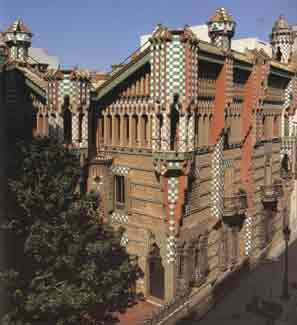Manuel Vicens i Montaner
 Manel Vicens i Montaner was a Trade agent. He acted around for the circles of the Renaixença and there he would have to know Anton Gaudí, which he was one of the first customers.
In 1878 he inherited from his mother a terrain in Gràcia (at present street Les Carolines) where he thought to construct a house, which he entrusted to Gaudí. The project was not specified until the 15th January of 1883, and the construction lengthened until 1888, according to the financial availability of the customer.
In this house, the construction of which was simultaneous with El Capricho in Comillas and with the pavilions of the estate Güell, the young artist was pushed in the new style that advocated Domènech i Montaner: the Modernism. He searched the roots of the Mudejar art, which he added up to his own originality and his innovative technical term.
Gaudí and Vicens were great friends. The architect used to spend some seasons in the house that Vicens had in the coastal village of Alella (el Maresme), in the street of Dalt (today Anselm Clavé). There, Gaudí got up at dawn and, accompanied of the old man "Bite", a Bohemian who made him of guide for the forest, he dedicated to drawing the leaves and the trees that picked up his attention. One time, coincided to be on the day of his saint patron, saint Antonius, and he dripped a doll to the small daughter of the family, who was called also Antonieta.
In July of 1883, Gaudí plotted a project of chapel of the Holy Sacrament for the parish church of Sant Feliu d'Alella, which lacked it.
In his step for Alella, also he left a first stretch of stair in the belfry of the same church and two furniture in the home Vicens: a graceful chimney corner of wood and metal and an angular cupboard.
In 1899, the widower of Manel Vicens, Dolors Giralt, sold Antoni Jover i Puig the house Vicens.
Manel Vicens i Montaner was a Trade agent. He acted around for the circles of the Renaixença and there he would have to know Anton Gaudí, which he was one of the first customers.
In 1878 he inherited from his mother a terrain in Gràcia (at present street Les Carolines) where he thought to construct a house, which he entrusted to Gaudí. The project was not specified until the 15th January of 1883, and the construction lengthened until 1888, according to the financial availability of the customer.
In this house, the construction of which was simultaneous with El Capricho in Comillas and with the pavilions of the estate Güell, the young artist was pushed in the new style that advocated Domènech i Montaner: the Modernism. He searched the roots of the Mudejar art, which he added up to his own originality and his innovative technical term.
Gaudí and Vicens were great friends. The architect used to spend some seasons in the house that Vicens had in the coastal village of Alella (el Maresme), in the street of Dalt (today Anselm Clavé). There, Gaudí got up at dawn and, accompanied of the old man "Bite", a Bohemian who made him of guide for the forest, he dedicated to drawing the leaves and the trees that picked up his attention. One time, coincided to be on the day of his saint patron, saint Antonius, and he dripped a doll to the small daughter of the family, who was called also Antonieta.
In July of 1883, Gaudí plotted a project of chapel of the Holy Sacrament for the parish church of Sant Feliu d'Alella, which lacked it.
In his step for Alella, also he left a first stretch of stair in the belfry of the same church and two furniture in the home Vicens: a graceful chimney corner of wood and metal and an angular cupboard.
In 1899, the widower of Manel Vicens, Dolors Giralt, sold Antoni Jover i Puig the house Vicens.
All rights reserved
Last update: 06/05/2016